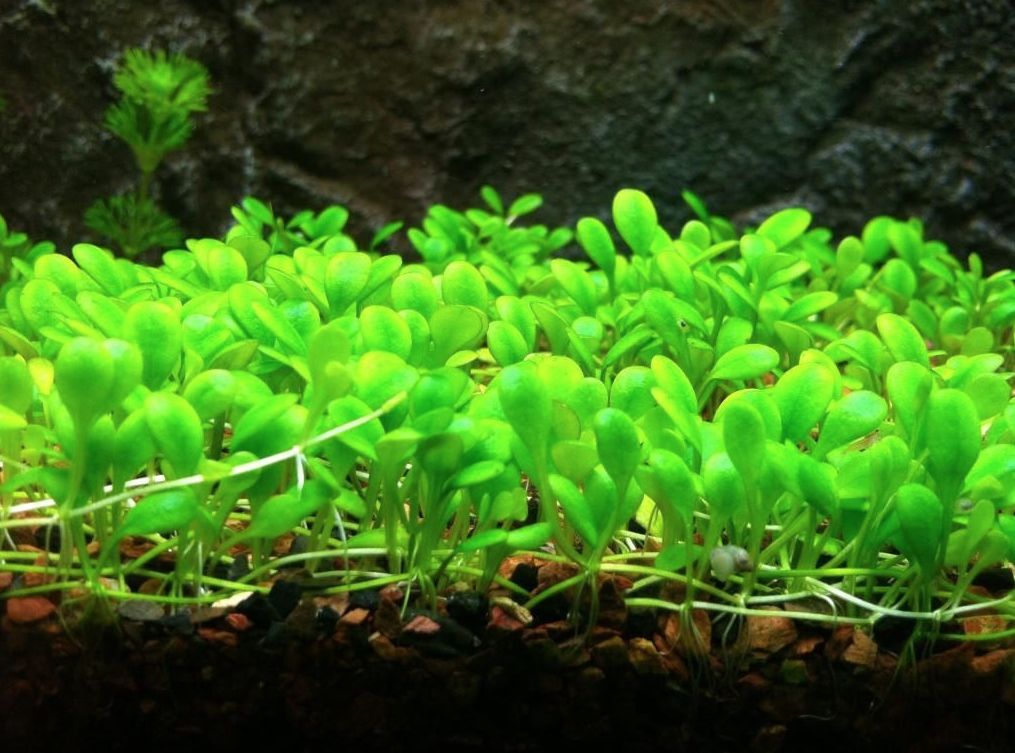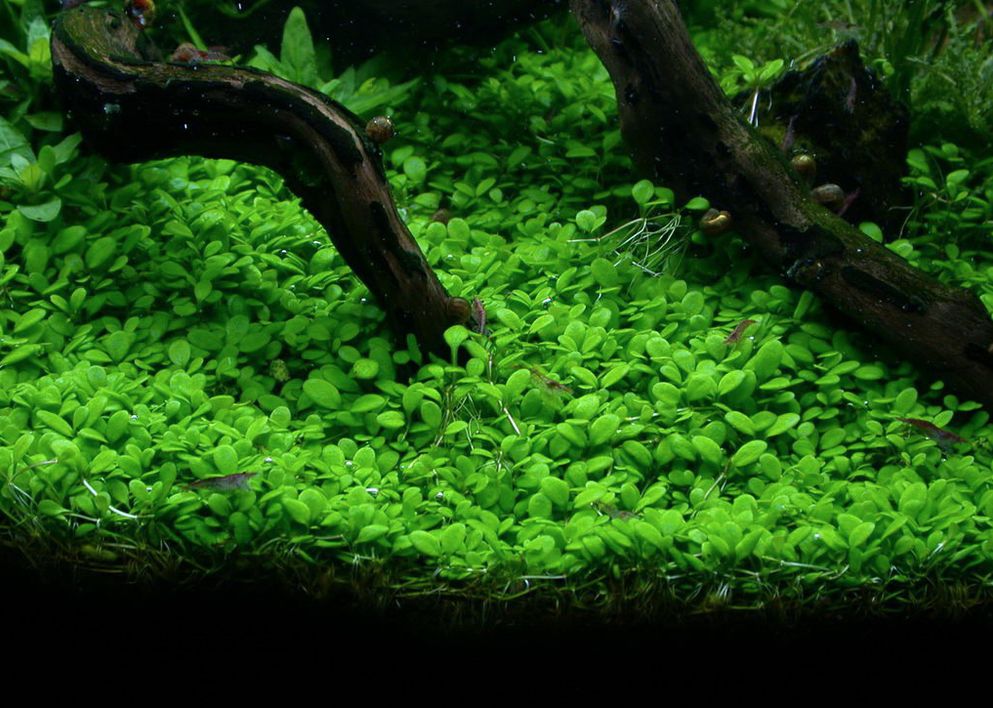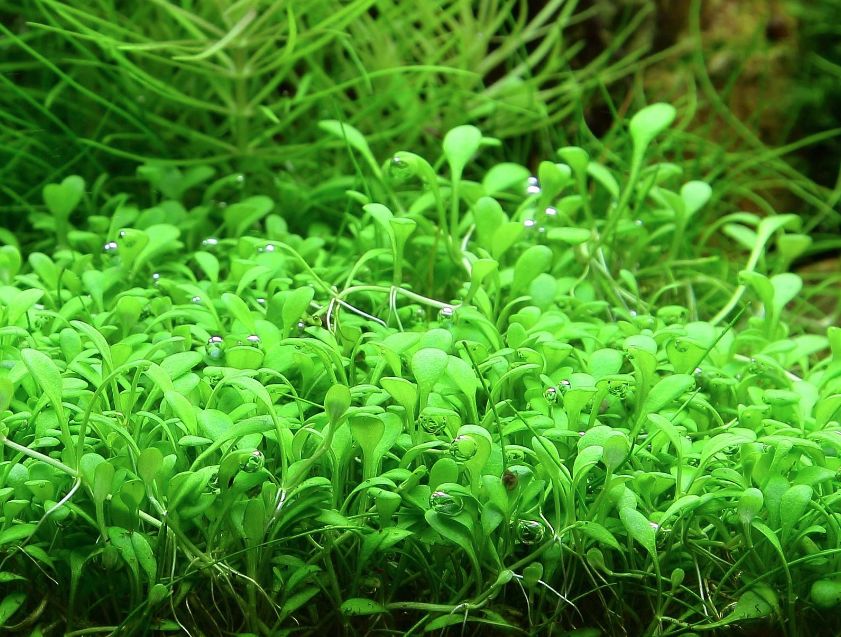Glossostigma elatinoides, commonly known as Glosso, is a sought-after aquatic plant in freshwater aquariums. This small, fast-growing plant is particularly favored for its ability to create a lush green carpet at the tank bottom, making it an excellent choice for the foreground. Glosso features delicate, curly branches that not only enhance visual appeal but also provide a habitat for small fish and invertebrates. Ideal conditions for Glosso include bright lighting and a nutrient-rich substrate, making it a rewarding addition for aquarists looking to elevate their tank’s aesthetic.

Contents
Plant Habitat in the wild
Glossostigma elatinoides, a member of the Scrophulariaceae family, has been a favorite among aquarium enthusiasts since the 1980s. It has gained particular popularity among professionals who create planted or natural aquariums. This versatile plant originates from New Zealand, Tasmania, and South-East Australia, thriving in bogs and lowland areas near water. In its natural habitat, Glosso is typically found along the edges of streams and rivers, where it enjoys slow to moderate water flow. While it can tolerate some current, excessive water movement can uproot this delicate plant.
Glosso is well-adapted to its environment, being a beach plant that occasionally experiences flooding. During the summer, when it emerges from the water, it blooms profusely. For aquarium keepers, replicating its natural conditions—bright light, nutrient-rich substrate, and gentle water flow—will help ensure healthy growth and a stunning display in the tank.

Description
Glossostigma elatinoides is a small-sized plant celebrated for its ability to create a stunning, visually appealing carpet in freshwater aquariums, typically measuring no more than 1 cm in thickness. Its compact growth forms a dense mat of vegetation that beautifully covers the substrate, making it an excellent choice for the foreground of aquascapes. The plant boasts rounded, light green leaves that reach up to 5 mm in size, with internodes averaging around 1 cm but capable of extending to about 5 cm. This active spreading habit can necessitate specific care to maintain the desired carpet effect.
The leaves are relatively flat and exhibit a glossy, vibrant green color, arranged in opposite pairs along delicate stems. Under optimal conditions, bubbles of oxygen may appear on the surface, signaling active photosynthesis and a healthy growth environment. Glosso is known for its rapid growth rate; when several bunches are planted close together, they can form a thick, smooth green carpet in just a few weeks. As the leaves overlap, they create a texture reminiscent of a green coat of mail when viewed from above, enhancing depth and visual interest in any aquarium setup.
| Feature | Glossostigma elatinoides |
|---|---|
| Common Name | Glosso |
| Origin | Australia, New Zealand, Tasmania |
| Growth Form | Ground-covering carpet plant |
| Leaf Size | Small, round or oval-shaped (< 1cm) |
| Leaf Color | Vibrant green |
| Growth Rate | Moderate to fast |
| Light Requirement | Moderate to high |
| CO2 Requirement | Beneficial but not mandatory |
| Water Temperature | 22°C to 28°C (72°F to 82°F) |
| pH Range | 6.0 to 7.5 |
| Water Hardness | Adaptable, prefers softer water |
| Propagation | Runners, division, and stem cuttings |
| Ideal Substrate | Nutrient-rich, fine-grained substrate |
| Water Flow | Moderate |
| Suitable for Beginners | Yes |
| Versatility | Suitable for foreground and carpeting |
| Maintenance | Regular trimming to maintain carpet |
| Compatibility | Compatible with most aquarium species |
| Ideal for Aquascaping | Yes |
Difficulties in keeping
Taking care about the plant is quite challenging and it isn’t likely to be within the power of a beginner aquarist. It requires high illumination level, quite soft (2 — 8°dKH) and slightly acidic (pH 5-7) water with temperature from 22 °C as well as occasional fertilization.
Despite the fact that the plant grows on the tank bottom, it requires high level of illumination, which must be taken into account when placing it in the tank.

Care and propagation in a tank
Lighting
Glossostigma elatinoides thrives under high lighting conditions, making the right lighting system essential for its successful growth in aquascapes. For optimal plant health and a lush carpet effect, it is recommended to use LED lights specifically designed for planted aquariums. These lights provide the intensity and spectrum needed for robust growth.
To achieve a thick carpet of Glosso, the illumination level in the tank should exceed 1 watt per liter, with a daylight duration of at least 8 hours each day. High-intensity lighting not only promotes healthy photosynthesis but also enhances the plant’s vibrant coloration. Popular options for LED lighting include brands like Fluval, Chihiros, and Current USA, which offer adjustable settings to meet the specific needs of aquatic plants.
By ensuring adequate lighting, aquarists can successfully cultivate Glosso and create a visually stunning carpet in their tanks, adding both beauty and ecological balance.
CO2
While not mandatory, injecting carbon dioxide (CO2) can significantly enhance the growth of Glossostigma elatinoides. CO2 supplementation promotes lush, compact growth, making it an excellent addition for aquarists aiming to achieve a dense carpet effect. By maintaining adequate carbon dioxide levels in the water, you can encourage the plant to thrive and display its vibrant coloration.
For effective CO2 injection, consider using a pressurized CO2 system, which provides a consistent and adjustable flow of gas. Popular options include systems from brands like Aquatec and Fluval, which come with regulators and diffusers to ensure efficient distribution in the aquarium. Additionally, utilizing a CO2 drop checker can help monitor levels, ensuring that your Glosso receives the optimal amount of carbon dioxide for robust growth.
Implementing CO2 supplementation, alongside proper lighting and nutrient-rich substrates, will help you cultivate a stunning carpet of Glosso, enhancing both the beauty and health of your aquarium. CO2 injection can increase plant growth rates by up to 50%, leading to a more vibrant and healthy aquascape. Moreover, it helps enhance the plant’s ability to compete with algae, improving overall tank health. A well-balanced CO2 system often includes a needle valve for precise adjustments and a solenoid to control the flow. Maintaining stable CO2 levels is crucial, as fluctuations can lead to plant stress. Many aquarists report improved coloration and leaf structure in Glosso when CO2 supplementation is used consistently.
Water Parameters
- Temperature: Maintain a temperature range of 22°C to 28°C (72°F to 82°F), which is suitable for most tropical aquarium setups.
- pH Level: Glossostigma elatinoides prefers a slightly acidic to neutral pH range of 6.0 to 7.5.
- Water Hardness: It can adapt to a wide range of water hardness levels but generally prefers softer water.
Substrate
The tank bottom substrate is crucial for the successful growth of Glossostigma elatinoides, ranking just behind lighting in importance. A substrate with smooth-edged grains, approximately 2-3 mm in size, is ideal. This type of substrate allows Glosso’s long, thin roots to penetrate deeply, promoting robust anchoring and growth.
In areas with larger-grained substrate, Glosso may struggle to form an attractive carpet. The plant either grows deep into the substrate or sends its shoots high above, which can result in an uneven appearance. By using a coarser substrate, you can also limit the plant’s propagation in undesired areas, giving you better control over its spread.
To optimize growth, use a nutrient-rich substrate or a layer of aquasoil specifically designed for planted aquariums. These substrates provide essential nutrients that enhance the health and vitality of Glossostigma elatinoides, ensuring that it flourishes and contributes to a vibrant aquascape. A nutrient-rich substrate not only supports plant growth but also encourages beneficial bacteria that improve water quality.
Some aquarists layer fine substrate over a coarser base, combining the benefits of both for better root penetration and nutrient access. Regular substrate maintenance, such as gentle stirring, can help release trapped gases and improve nutrient availability. Choosing the right substrate can reduce algae growth by promoting a healthier plant environment. Aquasoils often contain added minerals and fertilizers, providing a slow-release source of nutrients over time.
Fertilization
High illumination level requires additional CO2 supply (20-30 mg/l) and periodical fertilization, which is a must. Due to high growth rate of the plant, introduction of iron containing fertilizers is necessary to ensure saturated green coloring of the latter. Regularly provide essential nutrients to the plants through liquid fertilizers or root tabs. Look for fertilizers specifically formulated for aquatic plants and follow the dosage instructions.
Water Flow
Glossostigma elatinoides prefers moderate water flow. Ensure good water circulation in the aquarium, but avoid strong currents that may uproot or damage the delicate plant.

Glossostigma carpet
Glossostigma elatinoides is known for its fast growth, typically reaching heights of 2-3 cm (about 1 inch). However, under high illumination and with additional CO2 supplementation, it can maintain a more compact size, sometimes even smaller.
To maintain a healthy and visually appealing carpet, regular trimming is essential. If left unattended, Glosso may tear away from the substrate and float to the water’s surface. This can occur when lighting and nutrients fail to penetrate the lower layers of the carpet, leading to decay. Additionally, the rapid growth can cause the horizontally growing shoots to shade one another, resulting in longer stems as they stretch toward the light. To counteract this, it is recommended to cut back any vertically growing stems to encourage a more even carpet.
Trimming the carpet is straightforward. Use scissors held at a 45-degree angle for an even cut, though you don’t need to be overly meticulous. Aim to trim only the top portion of the stems, allowing the lower leaves to stay intact for better growth. If you accidentally tear some shoots away from the substrate, it’s best not to attempt replanting them, as they will likely not thrive.
While Glosso can survive under low lighting and without additional fertilization, it will not function effectively as a ground-covering plant under such conditions. Instead, it will begin to grow upwards, often exceeding 10 cm in height as it reaches for the light. This vertical growth can lead to a less attractive appearance and reduce the plant’s ability to form a dense carpet.
For best results, trim Glosso every few weeks, depending on growth rates and lighting conditions. Regular trimming not only keeps the carpet looking neat but also encourages denser growth and healthier plants. You can also experiment with varying trim heights to create interesting textures and enhance the visual depth of your aquascape.

How to plant glossostigma elatinoides
When planting Glossostigma elatinoides, begin by dividing the plant into separate clusters, each consisting of two leaves, and space them about 1-2 cm apart. Using pincers, bury each stem completely into the substrate to ensure it won’t float and to promote robust root development. Providing proper care can result in a lush green carpet within about a month.
Regular trimming is crucial for maintaining the health and aesthetics of Glosso. If the plant grows to about 5 cm in height without maintenance, it may detach from the substrate and float to the water’s surface. Glosso propagates through its trailing stems, which develop new roots at intervals. If a shoot is allowed to float, it can disrupt the substrate, causing other shoots to become detached as well. Instead, it’s better to simply cut off any overly long stems.
To ensure a dense and vibrant carpet, regularly remove old, yellowing leaves, as these can detract from the overall appearance of your aquascape. If any portions of the plant are severely affected by algae, it’s advisable to remove those sections entirely and replace them with healthy cuttings. By doing so, your small lawn can regain its lush appearance within a week.
Sources: